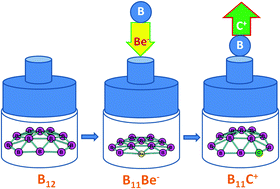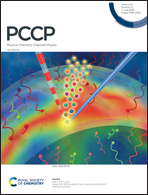Analysis of the electronic delocalization in some isoelectronic analogues of B12 doped with beryllium and/or carbon†
Abstract
In the current work, a new family of isoelectronic analogues to B12 is reported. The construction of this family was performed through the isoelectronic substitution principle to generate species such as B11C+, B11Be−, B10BeC, B10C22+, B10Be22− B9Be2C−, and B9BeC2+. The search for the global minimum was realized by utilizing genetic algorithms, while the induced magnetic field, electronic localization function, magnetic current densities, and multicenter aromaticity criteria were calculated to understand their electronic delocalization. Our results show that, in general, C atoms avoid hypercoordination, whereas we have found species with Be atoms located in hypercoordinated positions that are relatively stable. Our analysis of aromaticity indicates that B12 has double σ and π disk aromaticity. Mono, double or triple substitution of B by C+ or Be− reduces somewhat the aromaticity of the clusters, but less in the case of Be− substitution.

- This article is part of the themed collection: Celebrating Latin American Talent in Chemistry


 Please wait while we load your content...
Please wait while we load your content...